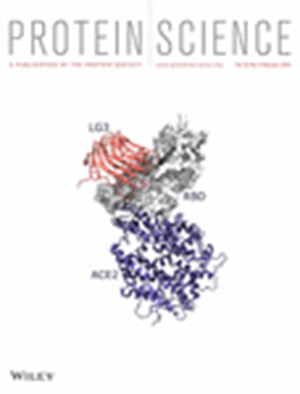Multiresolution molecular dynamics simulations reveal the interplay between conformational variability and functional interactions in membrane‐bound cytochrome P450 2B4
IF 4.5
3区 生物学
Q1 BIOCHEMISTRY & MOLECULAR BIOLOGY
引用次数: 0
Abstract
Cytochrome P450 2B4 (CYP 2B4) is one of the best‐characterized CYPs and serves as a key model system for understanding the mechanisms of microsomal class II CYPs, which metabolize most known drugs. The highly flexible nature of CYP 2B4 is apparent from crystal structures that show the active site with either a wide open or a closed heme binding cavity. Here, we investigated the conformational ensemble of the full‐length CYP 2B4 in a phospholipid bilayer, using multiresolution molecular dynamics (MD) simulations. Coarse‐grained MD simulations revealed two predominant orientations of CYP 2B4's globular domain with respect to the bilayer. Their refinement by atomistic resolution MD showed adaptation of the enzyme's interaction with the lipid bilayer, leading to open configurations that facilitate ligand access to the heme binding cavity. CAVER analysis of enzyme tunnels, AquaDuct analysis of water routes, and Random Acceleration Molecular Dynamics simulations of ligand dissociation support the conformation‐dependent passage of molecules between the active site and the protein surroundings. Furthermore, simulation of the re‐entry of the inhibitor bifonazole into the open conformation of CYP 2B4 resulted in binding at a transient hydrophobic pocket within the active site cavity that may play a role in substrate binding or allosteric regulation. Together, these results show how the open conformation of CYP 2B4 facilitates the binding of substrates from and release of products to the membrane, whereas the closed conformation prolongs the residence time of substrates or inhibitors and selectively allows the passage of smaller reactants via the solvent and water channels.多分辨率分子动力学模拟揭示了膜结合细胞色素 P450 2B4 的构象变化和功能相互作用之间的相互作用
细胞色素 P450 2B4(CYP 2B4)是表征最清楚的 CYPs 之一,是了解微粒体 II 类 CYPs 机理的关键模型系统。晶体结构显示,CYP 2B4 的活性位点具有一个开放或封闭的血红素结合腔,由此可见 CYP 2B4 的高度灵活性。在这里,我们利用多分辨率分子动力学(MD)模拟研究了全长 CYP 2B4 在磷脂双分子层中的构象组合。粗粒度 MD 模拟揭示了 CYP 2B4 的球状结构域相对于双分子层的两种主要取向。通过原子分辨率 MD 对其进行细化,显示了酶与脂质双分子层相互作用的适应性,从而形成了开放构型,有利于配体进入血红素结合腔。对酶隧道的 CAVER 分析、对水路的 AquaDuct 分析以及对配体解离的随机加速分子动力学模拟,都支持分子在活性位点和蛋白质周围之间的通道是随构象变化的。此外,对抑制剂联苯苄唑重新进入 CYP 2B4 开放构象的模拟结果显示,联苯苄唑与活性位点空腔内的一个瞬时疏水袋结合,该疏水袋可能在底物结合或异构调节中发挥作用。这些结果共同表明了 CYP 2B4 的开放构象如何促进底物与膜的结合以及产物向膜的释放,而封闭构象则延长了底物或抑制剂的停留时间,并选择性地允许较小的反应物通过溶剂和水通道。
本文章由计算机程序翻译,如有差异,请以英文原文为准。
求助全文
约1分钟内获得全文
求助全文
来源期刊

Protein Science
生物-生化与分子生物学
CiteScore
12.40
自引率
1.20%
发文量
246
审稿时长
1 months
期刊介绍:
Protein Science, the flagship journal of The Protein Society, is a publication that focuses on advancing fundamental knowledge in the field of protein molecules. The journal welcomes original reports and review articles that contribute to our understanding of protein function, structure, folding, design, and evolution.
Additionally, Protein Science encourages papers that explore the applications of protein science in various areas such as therapeutics, protein-based biomaterials, bionanotechnology, synthetic biology, and bioelectronics.
The journal accepts manuscript submissions in any suitable format for review, with the requirement of converting the manuscript to journal-style format only upon acceptance for publication.
Protein Science is indexed and abstracted in numerous databases, including the Agricultural & Environmental Science Database (ProQuest), Biological Science Database (ProQuest), CAS: Chemical Abstracts Service (ACS), Embase (Elsevier), Health & Medical Collection (ProQuest), Health Research Premium Collection (ProQuest), Materials Science & Engineering Database (ProQuest), MEDLINE/PubMed (NLM), Natural Science Collection (ProQuest), and SciTech Premium Collection (ProQuest).
 求助内容:
求助内容: 应助结果提醒方式:
应助结果提醒方式:


